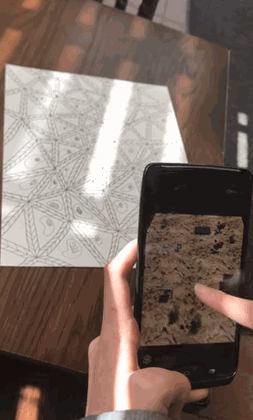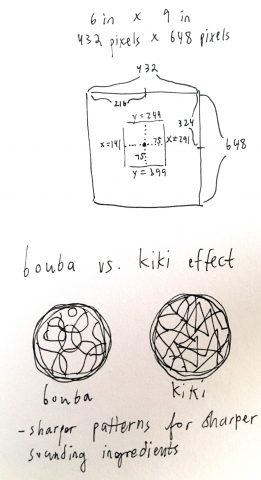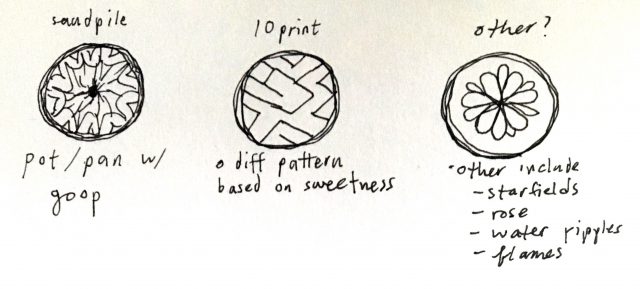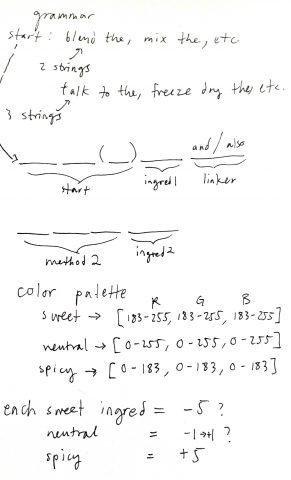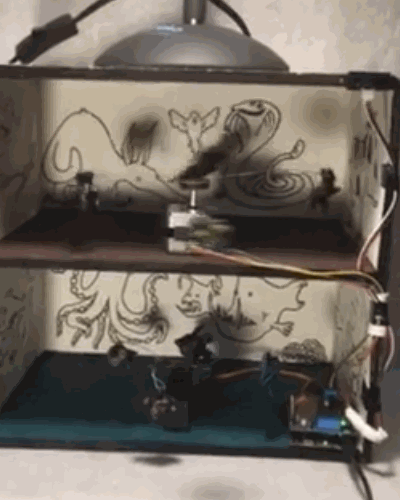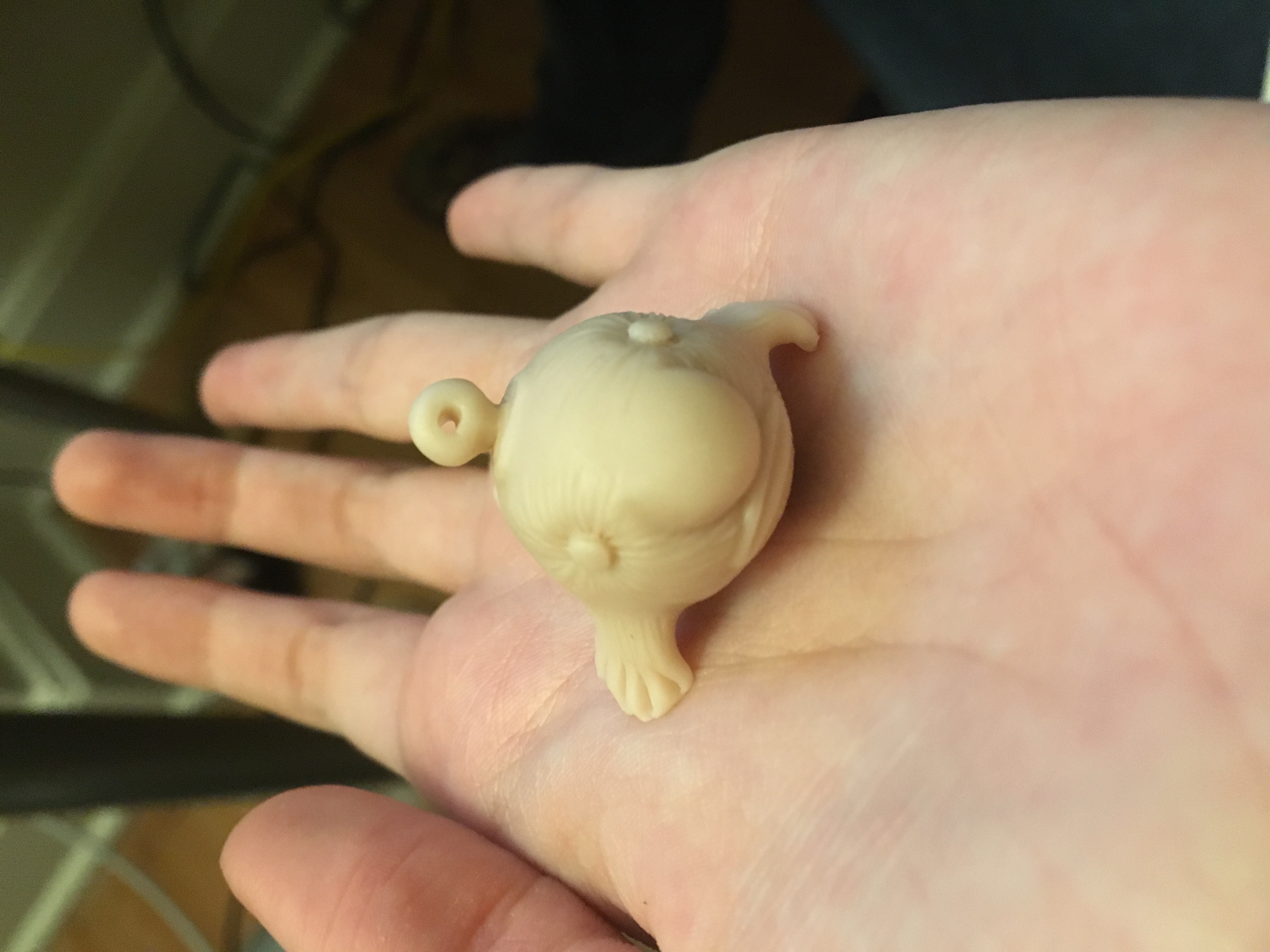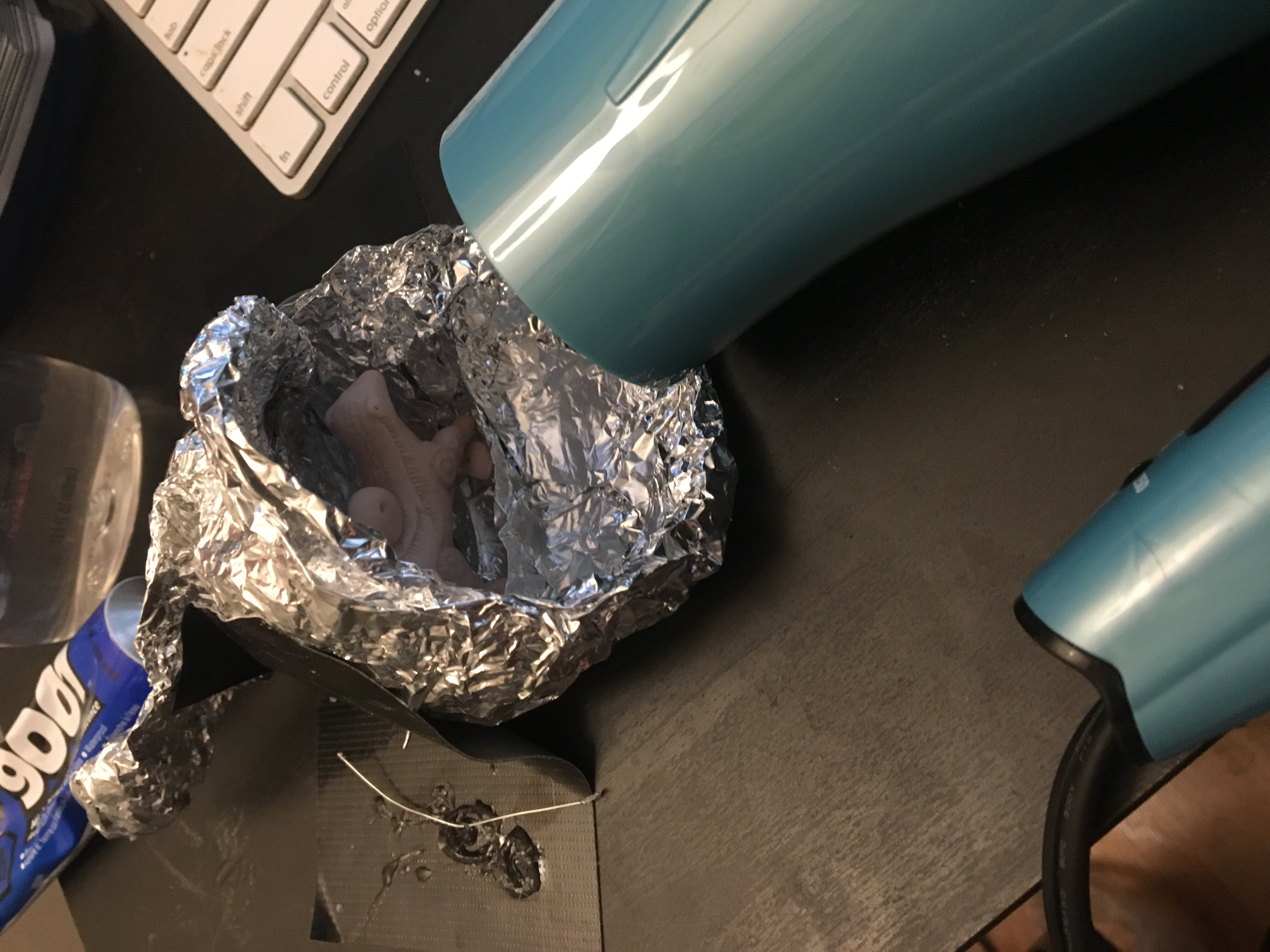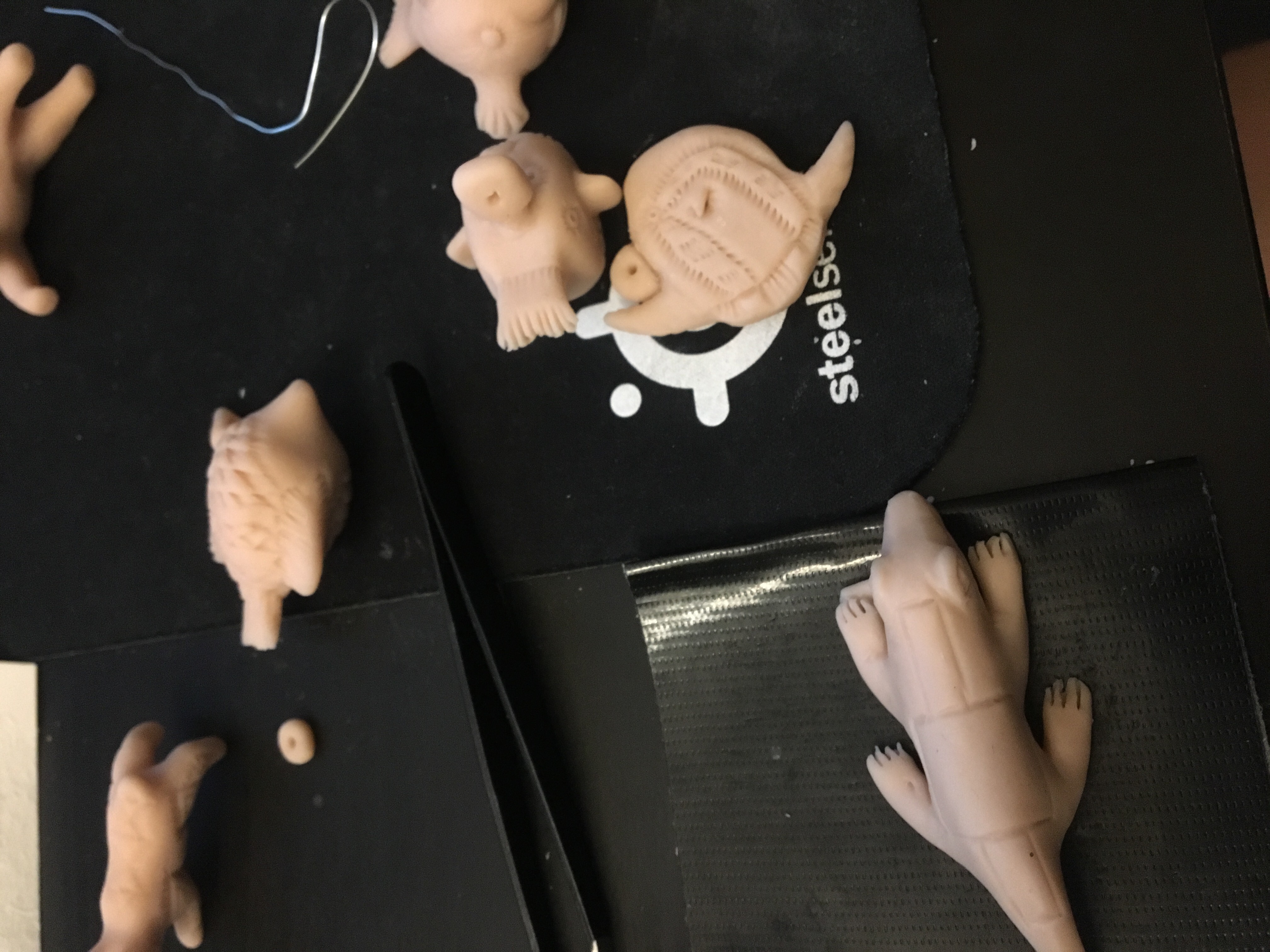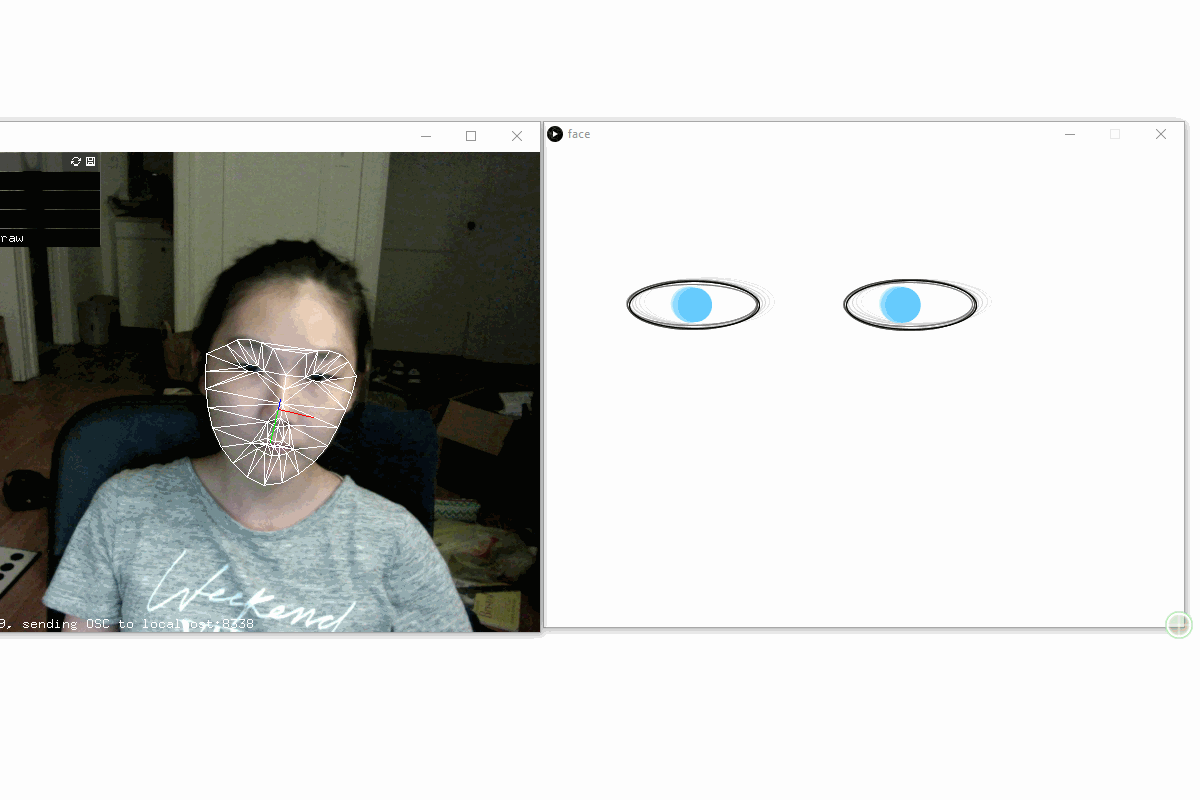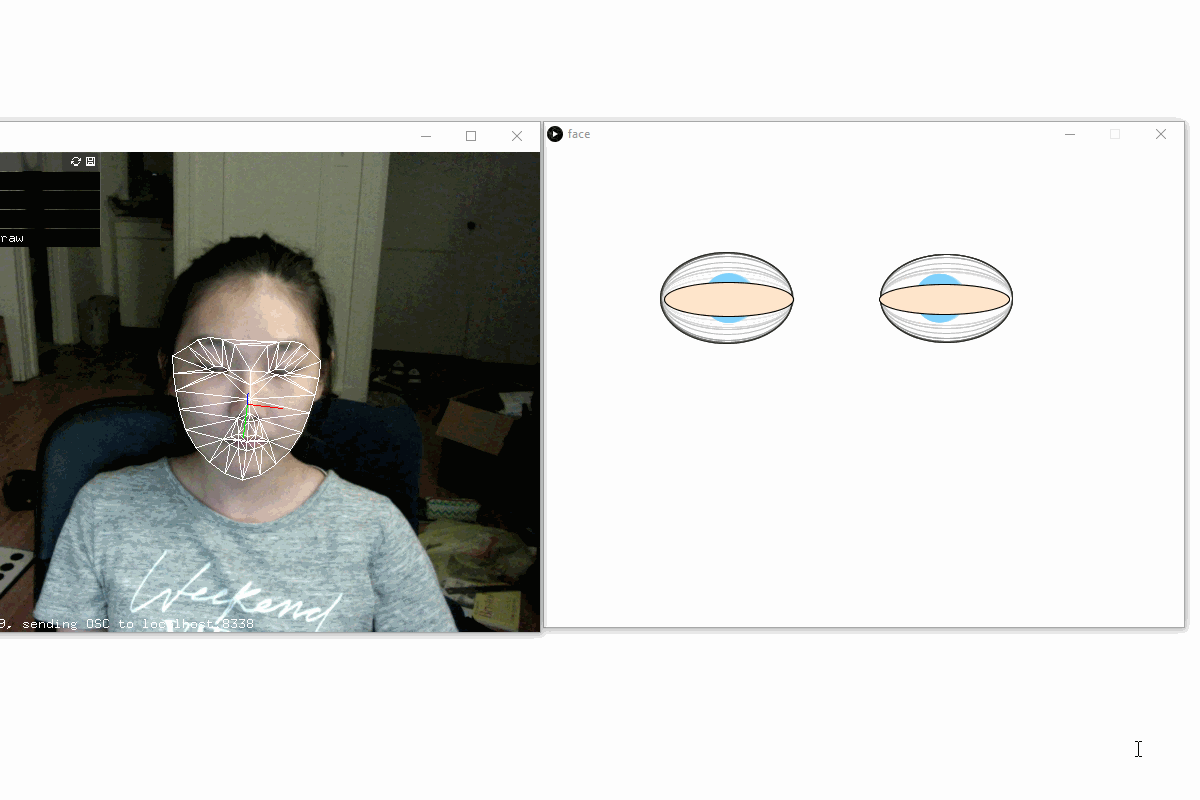//
// a template for receiving face tracking osc messages from
// Kyle McDonald's FaceOSC https://github.com/kylemcdonald/ofxFaceTracker
//
// 2012 Dan Wilcox danomatika.com
// for the IACD Spring 2012 class at the CMU School of Art
//
// adapted from from Greg Borenstein's 2011 example
// http://www.gregborenstein.com/
// https://gist.github.com/1603230
//
import oscP5.*;
OscP5 oscP5;
//I used Dan Shiffman's box2d adaptation: https://github.com/shiffman/Box2D-for-Processing
import shiffman.box2d.*;
import org.jbox2d.collision.shapes.*;
import org.jbox2d.common.*;
import org.jbox2d.dynamics.*;
import org.jbox2d.dynamics.joints.*;
Box2DProcessing box2d;
ArrayList<Boundary> boundaries;
ArrayList<ParticleSystem> systems;
ArrayList<Box> boxes;
// num faces found
int found;
// pose
float poseScale;
PVector posePosition = new PVector();
PVector poseOrientation = new PVector();
// gesture
float mouthHeight;
float mouthWidth;
float eyeLeft;
float eyeRight;
float eyebrowLeft;
float eyebrowRight;
float jaw;
float nostrils;
PImage outerEye;
float aVelocity = .05;
boolean mouseVelocity = false;
float angle = 0;
float amplitudeX = 200;
float amplitudeY = 200;
float theta = 0;
PVector location;
float centerX;
float centerY;
void setup() {
size(640, 480);
frameRate(30);
smooth();
box2d = new Box2DProcessing(this);
box2d.createWorld();
box2d.setGravity(0, -20);
systems = new ArrayList<ParticleSystem>();
boundaries = new ArrayList<Boundary>();
boxes = new ArrayList<Box>();
oscP5 = new OscP5(this, 8338);
oscP5.plug(this, "found", "/found");
oscP5.plug(this, "poseScale", "/pose/scale");
oscP5.plug(this, "posePosition", "/pose/position");
oscP5.plug(this, "poseOrientation", "/pose/orientation");
oscP5.plug(this, "mouthWidthReceived", "/gesture/mouth/width");
oscP5.plug(this, "mouthHeightReceived", "/gesture/mouth/height");
oscP5.plug(this, "eyeLeftReceived", "/gesture/eye/left");
oscP5.plug(this, "eyeRightReceived", "/gesture/eye/right");
oscP5.plug(this, "eyebrowLeftReceived", "/gesture/eyebrow/left");
oscP5.plug(this, "eyebrowRightReceived", "/gesture/eyebrow/right");
oscP5.plug(this, "jawReceived", "/gesture/jaw");
oscP5.plug(this, "nostrilsReceived", "/gesture/nostrils");
outerEye = loadImage("circlebig.png");
//boundaries.add(new Boundary(0,490,1280,10,0));
}
void draw() {
semiTransparent();
box2d.step();
for (ParticleSystem system: systems) {
system.run();
int n = (int) random(0, 2);
system.addParticles(n);
}
for (Boundary wall: boundaries) {
wall.display();
}
float varVelocity = calcVelocity(aVelocity);
PVector angularVelocity = new PVector (angle, varVelocity);
PVector amplitude = new PVector (amplitudeX, amplitudeY);
PVector location = calculateCircle(angularVelocity, amplitude);
//PVector centerCircle = calculateCenter(centerX, centerY);
pushMatrix();
if(found > 0) {
drawOscillatingX(location);
}
popMatrix();
for (Box b: boxes) {
b.display();
}
}
void semiTransparent() {
rectMode(CORNER);
noStroke();
float backColor = map (mouthHeight, 1, 5, 255, 0);
fill(backColor, backColor, backColor, 40);
rect(0,0, width, height);
stroke(0);
noFill();
}
//basics of eye blink, iris movement from: https://raw.githubusercontent.com/jayjaycody/ComputationalCameras/master/wk3_Face/jai_face_keyPressComplexity/jai_face_keyPressComplexity.pde
float calcVelocity(float aVelocity) {
float velocity = aVelocity;
if (mouseVelocity == false) {
}
if (mouseVelocity == true) {
velocity = map(mouseX, 0, width, -1, 1);
}
return velocity;
}
PVector calculateCircle (PVector angularVelocity, PVector amplitude) {
float x = amplitude.x * cos (theta);
float y = amplitude.y * sin (theta);
location = new PVector (x, y);
theta += angularVelocity.y;
return location;
}
PVector calculateCenter (float centerX, float centerY) {
PVector centerCircle = new PVector (centerX, centerY);
return centerCircle;
}
void drawOscillatingX (PVector location) {
float mouthScalar = map(mouthWidth, 10, 18, 0, 1.5); // make a scalar for location.x as a function of mouth
location.mult(mouthScalar);
float newPosX = map (posePosition.x, 0, 640, 0, width);
float newPosY = map(posePosition.y, 0, 480, 0, height);
translate(width - newPosX, newPosY-100);
scale(poseScale*.3);
float irisColR = map (mouthHeight, 1, 5, 102, 204);
float irisColG = map (mouthHeight, 1, 5, 204, 51);
float irisColB = map (mouthHeight, 1, 5, 255, 0);
float leftEyeMove = map(location.x, - amplitudeX, amplitudeX, -25, 33);
pushMatrix();
translate (leftEyeMove, 0);
//Left iris
fill(irisColR, irisColG, irisColB);
noStroke();
float eyeMult = map (mouthHeight, 1, 5, 1, 2);
float irisSizeL = map (eyeLeft, 2, 3.5, 0, 50);
ellipse(-100, 0, irisSizeL * eyeMult, irisSizeL * eyeMult);
////LeftPupil
float eyeOutlineCol = map (mouthHeight, 1, 5, 0, 255);
popMatrix();
float rightEyeMove = map(location.x, - amplitudeX, amplitudeX, -33, 25);
pushMatrix();
translate(rightEyeMove, 0);
//right EYE
//Right Iris
fill(irisColR, irisColG, irisColB);
noStroke();
float irisSizeR = map (eyeRight, 2, 3.5, 0, 50);
ellipse(100, 0, irisSizeR * eyeMult, irisSizeR * eyeMult);
//Right Pupil
stroke(eyeOutlineCol);
popMatrix();
noFill();
//get eye informatio and set scalar
float blinkAmountRight = map (eyeRight, 2.5, 3.8, 0, 125);
float blinkAmountLeft = map (eyeLeft, 2.5, 3.8, 0, 125);
float eyeMultiplier = map (mouthHeight, 1, 5, 1, 3);
// right eye size, blink and movement
ellipse (100, 0, amplitudeX *.6, blinkAmountRight * eyeMultiplier); //scalar added to eyeHeight
if (eyeRight < 2.7) {
fill(255, 230, 204);
ellipse (100, 0, amplitudeX *.6, blinkAmountRight*1.6 * (4 * eyeMultiplier/5)); //scalar added to eyeHeight
noFill();
}
//left eye size, blink, and movement
ellipse (-100, 0, amplitudeX *.6, blinkAmountLeft * eyeMultiplier);
if (eyeLeft < 2.7) {
fill(255, 230, 204);
ellipse (-100, 0, amplitudeX *.6, blinkAmountLeft*1.6 * (4 * eyeMultiplier/5)); //scalar added to eyeHeight
noFill();
}
if (mouthHeight > 3.3) {
//float mapScale = map (poseScale, 0, 4, 0, 1);
pushMatrix();
//translate(posePosition.x, posePosition.y);
//scale(poseScale);
Box p = new Box((width - posePosition.x - 100), (posePosition.y - 50));
Box q = new Box((width - posePosition.x + 100), (posePosition.y - 50));
boxes.add(p);
boxes.add(q);
popMatrix();
}
}
public void found(int i) {
println("found: " + i);
found = i;
}
public void poseScale(float s) {
println("scale: " + s);
poseScale = s;
}
public void posePosition(float x, float y) {
println("pose position\tX: " + x + " Y: " + y );
posePosition.set(x, y, 0);
}
public void poseOrientation(float x, float y, float z) {
println("pose orientation\tX: " + x + " Y: " + y + " Z: " + z);
poseOrientation.set(x, y, z);
}
public void mouthWidthReceived(float w) {
println("mouth Width: " + w);
mouthWidth = w;
}
public void mouthHeightReceived(float h) {
println("mouth height: " + h);
mouthHeight = h;
}
public void eyeLeftReceived(float f) {
println("eye left: " + f);
eyeLeft = f;
}
public void eyeRightReceived(float f) {
println("eye right: " + f);
eyeRight = f;
}
public void eyebrowLeftReceived(float f) {
println("eyebrow left: " + f);
eyebrowLeft = f;
}
public void eyebrowRightReceived(float f) {
println("eyebrow right: " + f);
eyebrowRight = f;
}
public void jawReceived(float f) {
println("jaw: " + f);
jaw = f;
}
public void nostrilsReceived(float f) {
println("nostrils: " + f);
nostrils = f;
}
// all other OSC messages end up here
void oscEvent(OscMessage m) {
if(m.isPlugged() == false) {
println("UNPLUGGED: " + m);
}
} |
